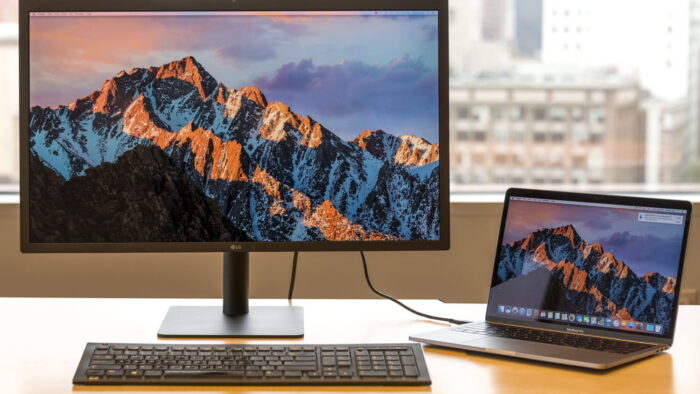Would you like some guidance on selecting a new monitor? Clients often ask me to recommend a good monitor or tell them which monitor they should buy. These requests are actually surprisingly difficult for two reasons. First, there are numerous monitor manufacturers and each company makes a range of models so it’s tough to track the entire market. Second, people’s individual needs vary. Consequently, rather than recommend one or two particular monitors, I often start by outlining the range of monitor features to help people select an appropriate monitor for their needs.
These recommendations are for a typical user, not for photo editors, architects, video-gamers and others who might have more specific needs.
When reading monitor reviews there are a lot of terms that gets listed such as: brightness, contrast, refresh rate, response time, screen type. For the average user, much of this isn’t critical. I would encourage you to primarily focus on the price of the monitor as well as the following 4 criteria: screen size, screen resolution, height adjustability and connectors. Additionally, you could think about speakers, webcam and mountability. Let me elaborate a bit on each of these.
Screen size – How much working space do I need and will the monitor fit on my desk? Currently, the most common monitor sizes are 24 inches and 27 inches, but one can also buy ultrawide monitors that are commonly have screen sizes of 30-34 inches. Some are even bigger.
Screen Resolution – Can I adjust the resolution to a size that’s comfortable for my eyes? A monitor’s highest resolution will always be the sharpest image it can draw. When you lower the resolution, which makes the image bigger and easier to see, the image also gets a touch fuzzier. This is an unfortunate trade-off.
If you’re going to spend many hours looking your monitor you might want to consider buying a monitor with a high resolution and high refresh rate since it could reduce eye strain. 4K monitors have a resolution that is four times high-definition (HD). The price of 4K monitors continues to inch down so they are becoming more and more affordable. I use a 4K monitor whose resolution I have set to 2560 x1440. This allows me to use the left two-thirds of my monitor for my primary work space such as my email or web browsing. The right third of my monitor is dedicated to quick reference stuff such as my text messages or passwords manager.
Height Adjustability – Does the monitor stand let me easily adjust the height up and down so I can find the best position that doesn’t give me a sore neck?
Similarly, look at the monitor’s base. I tend to like monitors that have heavy, solid bases, such as a slab base. I tend to dislike monitor’s that are supported by a couple of spindly legs.
Connectors – What ports does the monitor have and thus what cable or adapter would I need to connect it to my Mac. Most monitors will come equipped with one or more of the following types of connectors: HDMI, USB-C, Thunderbolt, DVI and VGA. HDMI, USB-C and Thunderbolt connectors are the most useful ones for most Mac users since both all of these connectors can carry both audio and video signals. USB-C and Thunderbolt have the advantage of being able to carry power. If you have a Mac laptop with a USB-C/Thunderbolt connector you could potentially charge your laptop’s battery using the USB-C cable that connects your laptop to your monitor.
Webcam, speakers and mountability – Some monitors include speakers but many do not. Every Mac includes at least one speaker but Apple has traditionally put only one speaker in the Mac mini and Mac Studio so you might want to consider connecting quality speakers to your Mac or get a monitor with speakers built-in.
Most monitors do not include a webcam. If you plan on using FaceTime, Zoom or another video conferencing application then you could either look for a monitor with a webcam built-in or you could buy a webcam separately or consider using your iPhone as your webcam.
Apple’s Studio Display includes a 12 megapixel camera, 6 microphones and 6 speakers so it’s definitely an option to consider if these features are important to you. Check out other monitors with built-in webcams and speakers from PopSci and CreativeBloq.
Some users might want to free up some desk space by getting their monitor off their desk. Wall-mountable monitors will be listed as VESA compatible or VESA compliant. If you want to buy a VESA mount check out Ergotron and Ergomart.
Now that you’re equipped with what you want to look for when shopping for a monitor, here are some sites I use to find good monitor options.
Wirecutter, a gear and gadget review site owned by the NY Times, offers monitor recommendations in these categories:
Wirecutter Best Ultrawide Monitors
Wirecutter lets you view a few articles for free. Beyond that a subscription is required.
MacHow2 Best 5K monitors – several include webcams and mics
MacHow2 Alternatives to Apple Studio Display
PCMag offers similar recommendations in these categories:
NYMag’s The Strategist which offers these recommendations:

